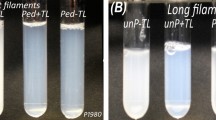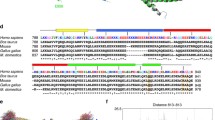Summary
The effect of MgATP on myosin filament assembly has been studied. Filaments were assembled by a standard dilution procedure involving two steps, dilution from 0.6 to 0.3m KCl and from 0.3 to 0.15m KC1 with a different rate of dilution in each step. This standard dilution procedure gives filaments which are structurally similar to native filaments in that they have a sharp length distribution around 1.5 μm, a diameter of 16 nm and they vary in length with KCl concentration in a similar manner to native filaments. The addition of 1mm MgATP leads to a sharpening of the length distribution around 1.5 μm without change in the 16 nm diameter. Filaments assembled by dialysis or by rapid dilution are not similarly affected by the presence of MgATP indicating that the standard dilution procedure produces filaments which are more closely similar to native filaments than those produced by these other methods. MgAMPPNP and magnesium pyrophosphate have the same effect as MgATP thus eliminating the possibility that phosphorylation of the myosin is involved in the effect. The effect of MgATP is not directly related to its binding to the active site of the myosin molecule since a 500∶1 mole ratio of MgATP to myosin is required for the effect. It is therefore likely that the effect of MgATP is related to other binding sites on the myosin molecule.
The presence of MgATP leads to molecular rearrangements which finely tune the molecular organization of the filaments formed by the standard dilution procedurein vitro. It is likely that the MgATP present in living cells may similarly be responsible for the fine tuning of the molecular assembly of the myosin filaments to produce uniform lengthsin vivo.
Similar content being viewed by others
References
Bartles, E. M., Cooke, P. H., Elliott, G. F. &Hughes, R. A. (1984) Donnan potential changes in rabbit muscle A-bands are associated with myosin.Proc. Physiol. Soc. 358, 80P.
Harrington, W. J. &Himmelfarb, S. (1972) Effect of adenosine di- and tri-phosphates on the stability of synthetic myosin filaments.Biochemistry 11, 2945–52.
Huxley, H. E. (1963) Electron microscopic studies on the structure of natural and synthetic protein filaments from striated muscle.J. molec. Biol. 7, 281–308.
Infante, A. A. &Davies, R. E. (1965) The effect of 2, 4 dinitrofluorobenzene on the activity of striated muscle.J. biol. Chem. 240, 3996–4001.
Kaminer, B. &Bell, A. L. (1966a) Synthetic myosin filaments.Science, N.Y. 151, 323–4.
Kaminer, B. &Bell, A. L. (1966b) Myosin filamentogenesis: Effects of pH and ionic concentration.J. molec. Biol. 20, 391–401.
Katsura, I. &Noda, H. (1973a) Further studies on the formation of reconstituted myosin filaments.J. Biochem., Tokyo 73, 245–56.
Katsura, I. &Noda, H. (1973b) Assembly of myosin molecules into the structure of thick filaments of muscle.Adv. Biophys. 5, 177–202.
Morimoto, K. &Harrington, W. F. (1973) Isolation and composition of thick filaments from rabbit skeletal muscle.J. molec. Biol. 77, 165–75.
Offer, G., Moos, C. &Starr, R. (1973) A new protein of the thick filaments of vertebrate skeletal myofibrils. Extraction, purification and characterization.J. molec. Biol. 74, 653–76.
Pepe, F. A. (1982) The structure of vertebrate skeletal muscle myosin filaments. InCell and Muscle Motility (edited byShay, J. W. andDowben, R. M.) pp. 141–71. New York: Plenum Press.
Pepe, F. A. (1983) Macromolecular assembly of myosin. InMuscle and Nonmuscle Motility (edited byStracher, A.), pp. 105–49. New York: Academic Press.
Pepe, F. A., Drucker, B. &Chowrashi, P. K. (1986) The yosin filament. XI. Filament assembly.Prog. Biochem. 16, in press.
Pinset-Harstrom, I. &Truffy, J. (1979) Effect of adenosine triphosphate, inorganic phosphate and divalent cations on the size and structure of synthetic myosin filaments.J. molec. Biol. 134, 173–88.
Pinset-Harstrom, I. (1985) MgATP specifically controlsin vitro self-assembly of vertebrate skeletal myosin in the physiological pH range.J. molec. Biol. 182, 159–72.
Richards, E. G., Chung, C. S., Menzel, D. B. &Olcott, M. S. (1967) Chromatography of myosin on diethylaminoethyl-Sephadex A-50.Biochemistry 6, 528–40.
Trinick, J. &Cooper, J. (1980) Sequential disassembly of vertebrate muscle thick filaments.J. molec. Biol. 141, 315–21.
Author information
Authors and Affiliations
Rights and permissions
About this article
Cite this article
Chowrashi, P.K., Pepe, F.A. The myosin filament. XII. Effect of MgATP on assembly. J Muscle Res Cell Motil 7, 413–420 (1986). https://doi.org/10.1007/BF01753584
Received:
Revised:
Issue Date:
DOI: https://doi.org/10.1007/BF01753584




